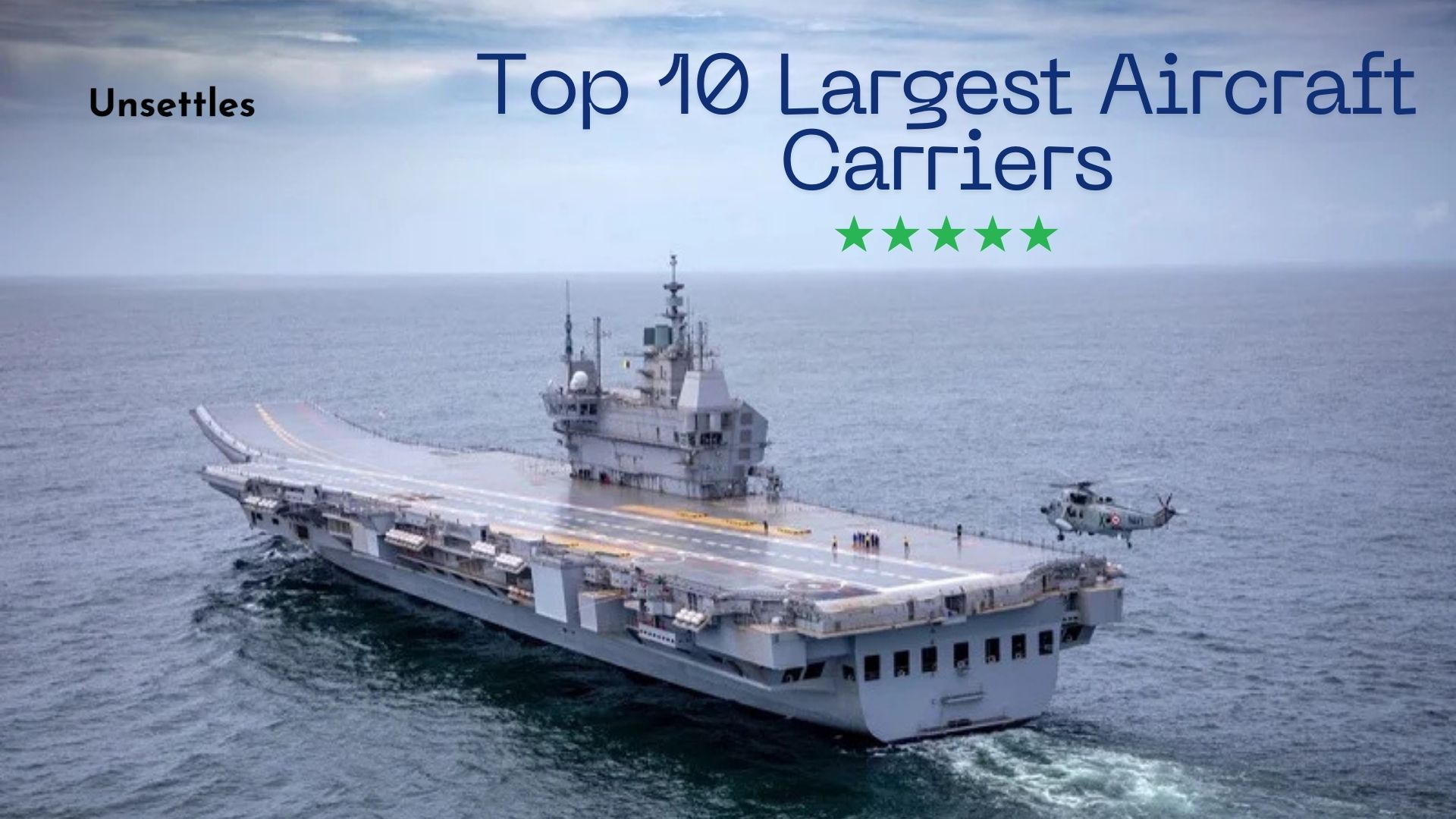Largest Aircraft Carriers: Aircraft carriers are the backbone of modern naval strength, allowing nations to project power far from their shores. When measuring a country’s naval prowess, the size and capabilities of its aircraft carriers are crucial. Here’s a look at the top 10 largest aircraft carriers in the world, each an impressive feat of engineering and technology.
1. The Gerald R. Ford Class (USA)
As the world’s most advanced aircraft carrier, the Gerald R. Ford Class sets new standards in naval engineering for the U.S. Navy. Delivered in 2017 to replace older Nimitz-class carriers, it boasts a massive 100,000-ton displacement. Equipped with the latest Electromagnetic Aircraft Launch System (EMALS) and advanced arresting gear, this carrier supports over 75 aircraft and offers a 250% increase in electrical capacity. Largest Aircraft Carriers
2. The Nimitz Class (USA)
The Nimitz class, introduced in 1975, remains among the largest warships ever built. Weighing in at 97,000 tons and stretching over 332.8 meters, these carriers house advanced missile systems and are nuclear-powered, capable of 20+ years of operation without refueling. With a flight deck spanning 4.5 acres, the Nimitz class supports over 60 aircraft.
3. CNS Fujian (Type 003) (China)
Launched in 2022, CNS Fujian represents China’s leap in naval power. Weighing over 80,000 tons, it’s the first Chinese carrier to use an electromagnetic launch system similar to the U.S. Ford Class, allowing it to launch a wider range of aircraft efficiently. This advanced capability signals China’s intent to expand its influence, particularly in the South China Sea.
4. Queen Elizabeth Class (UK)
The UK’s largest warships, HMS Queen Elizabeth and HMS Prince of Wales, each displace 65,000 tons. Built to carry up to 40 aircraft, including F-35B stealth fighters, they feature dual flight decks and prioritize both operational efficiency and safety. These carriers are central to the UK’s maritime strategy and global presence. Largest Aircraft Carriers
5. Admiral Kuznetsov (Russia)
Russia’s Admiral Kuznetsov, weighing 58,500 tons, serves as the Russian Navy’s flagship. Unlike Western carriers, it includes substantial anti-ship and anti-aircraft missile systems, making it capable of both air superiority and surface combat missions. Its versatility reflects a unique approach to carrier design.
6. Shandong (Type 002) (China)
Commissioned in 2019, the Shandong is China’s first domestically-built carrier, weighing between 66,000 and 70,000 tons. It features a ski-jump launch and an angled flight deck to improve aircraft operations, significantly enhancing China’s naval reach. Largest Aircraft Carriers
7. Liaoning (Type 001) (China)
China’s first aircraft carrier, the Liaoning, was originally a Soviet Kuznetsov-class carrier, bought and refurbished by China. At 58,000 tons, it mainly serves as a training vessel but has laid the groundwork for China’s carrier development program.
8. INS Vikramaditya (India)
India’s INS Vikramaditya, a refitted Russian Kiev-class cruiser, displaces 44,500 tons. Fitted with a Short Take-Off But Arrested Recovery (STOBAR) system, it supports MiG-29K fighter jets and underscores India’s growing naval influence in the Indian Ocean region.
9. Charles de Gaulle (R91) (France)
France’s flagship, Charles de Gaulle, is the only active nuclear-powered carrier outside the U.S. Navy, weighing 42,000 tons. Capable of carrying 40 aircraft, including Rafale M fighters, it enables France to project power globally without the need for frequent refueling. Largest Aircraft Carriers
10. INS Vikrant (India)
Set to be fully operational by 2024, INS Vikrant will mark a significant step for India’s naval capabilities. Displacing 40,000 tons and equipped with a STOBAR system, it supports India’s ambitions for a stronger maritime presence in the region.
Final Thoughts
These impressive Largest Aircraft Carriers play vital roles in each nation’s defense and power projection strategies. While this list may stay similar over the next few years due to the complexity and cost of building new carriers, any future additions or advancements in carrier technology will only increase the capabilities of these naval giants.
FAQs about Largest Aircraft Carriers
What makes the Gerald R. Ford Class the most advanced aircraft carrier?
The Gerald R. Ford Class boasts a 100,000-ton displacement, supports over 75 aircraft, and features cutting-edge systems like EMALS and advanced arresting gear, providing unmatched capabilities.
Why does China’s CNS Fujian use electromagnetic launch technology?
By adopting an electromagnetic launch system, the CNS Fujian can efficiently launch a variety of aircraft, enhancing operational flexibility compared to older ski-jump designs.
What’s unique about Russia’s Admiral Kuznetsov carrier?
Admiral Kuznetsov is armed with significant anti-ship and anti-aircraft systems, making it a unique “hybrid” capable of both air superiority and surface combat roles.
How does the Queen Elizabeth Class support the UK’s global maritime strategy?
With a 65,000-ton displacement and ability to carry advanced F-35B fighters, these carriers enable the UK to project power, support allies, and maintain a strong maritime presence.
Is INS Vikrant fully operational yet?
INS Vikrant, launched in 2013, is expected to be fully operational by 2024, adding another critical asset to India’s growing naval capabilities.
